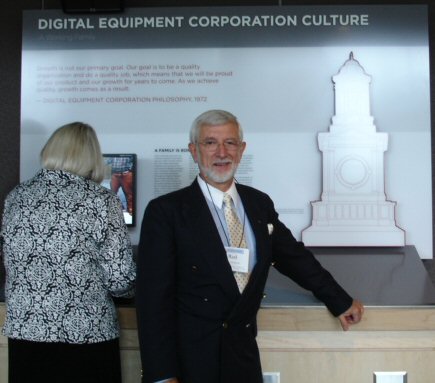|
Addendum: "Ken's Kaleidoscope" - by Rod
Sutherland It has long been
my considered observation that companies tend to build products in their own
image.
One needs only to look at the slick,
sealed, tightly controlled and ever-so-proprietary iMac or iPod or iPhone as
a good example today of how products of a company can reflect their culture
and even the personality of their leader or founder.
HP in it's earliest years was a
company focused on the lab... on research and on strong and creative product
lines and still is today.
IBM was very much a top-down
hierarchically managed organization and it's products certainly reflected
that culture.
This is a good thing... it helps the
designers and other employees as a sort of compass and helps to inform
customers and partners so that they can make plans or at least not suffer
surprises or missed expectations.
It is in the area of communications
and networking technologies that we can find the Digital difference. I saved
this for last because it is here that Digital leadership and culture shine
most brightly in the kaleidoscope.
It is no surprise that the openness of
the Digital culture and the peer-to-peer values of our people spawned a set
of products and a networking architecture that was a direct reflection of
those values.
For all of our years that style of
network connectivity and openness grew by leaps and bounds in capacity and
capability. In a very real way each of our computers could collaborate as a
peer with any other of our computers across our networks without regard for
its power or its position...just like Digital employees!
The rate in which our DECnet
capabilities grew was a mirror of how fast our company grew and even the way
that our products "connected" became the norm for how other products evolved
in the marketplace.
Consider the Ethernet: it began as 1
megabit connection, peer-to-peer with few restrictions. Any computer
connected could communicate/share with any other connected computer. IBM
offered an alternative technology known as Token Ring. It was faster at 1.6
megabits and very predictable in it's performance. IBM attacked the Ethernet
design as "indeterminate" and therefore suspect.
The very fact that it was
"indeterminate" became the real value of Ethernet even as it grew to 10
mbits (Token Ring countered with 16 mbits) then 100 mbits (Token Ring
dropped out by then) and today is found in Apple MACbook pros and other
laptops at a full 1000 mbits! (This, after all, was the way that DEC people
and processes worked...)
This flexibility of interconnection
was a the heart of many other technologies during that time. Consider
VAXclusters. As the needs of our customers grew to incredible level
requiring computing capacities that were beyond the abilities of any single
machine. Our natural answer was to connect many machines, via fibre optics,
in a cluster of peers... very powerful peers... to create massive
capabilities.
At IBM their culture would set out to
build a bigger machine... at HP they went into the labs and worked on an
extremely complex solution (not elegantly simple) that took many years to
find its way into products. (my favorite story in this area was from Dr.
Grace Hopper who said it best..."When the early farmers needed to pull a
large stump from their fields they didn't grow a bigger ox, they harnessed
many oxen together to solve the problem!")
Today this approach is found it the
work of Intel and AMD as they bring more and more CPUs together connected
via common memory. 2,4,6,8 and soon more CPUs in multi-core chips are
rapidly becoming the norm from both companies. It is clustering at the chip
level and will continue for some time to come.
The style of networking that we
espoused and the style of communication that we used on our work is to be
found over and over in the World-wide Web today. Things like VAXnotes are
the RSS feeds of today. Generations of intelligent storage systems find so
much of their roots in the work at Digital in those years.
It is in the networking area that
Ken's guidance of "Elegant Simplicity" showed so much of its value and still
does... nothing else compares.
Finally, it was with each twist of
Ken's Kaleidoscope that we were able to connect, reconnect, grow and respond
to the marketplace needs of the day so adroitly... until the "rules" changed
in the market and good-enough engineering at good-enough prices ruled the
day.
Yet we all must remember that while
where we did all this is no longer what we did, together, lives on and
thrives.
P.S. As a personal footnote I think it
is worth observing that a Kaleidoscope has little beauty and little result
unless the hand that holds it aims it up... into the light... and Ken
certainly knew where that light was. It doesn't work at all if someone
removes many of the jewels inside, turns it back and forth erratically or
turns it away from the light.
|


